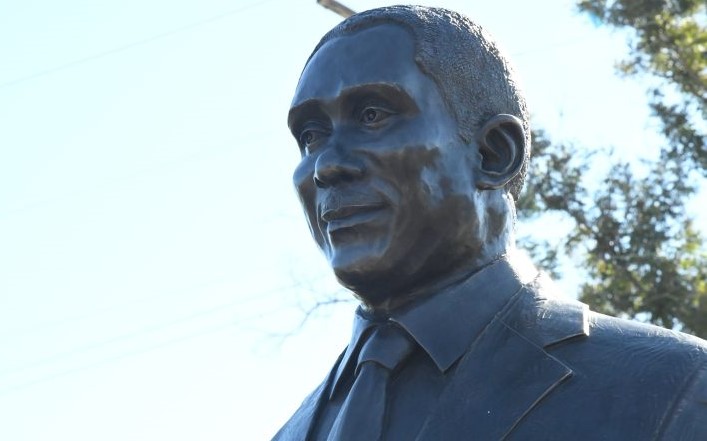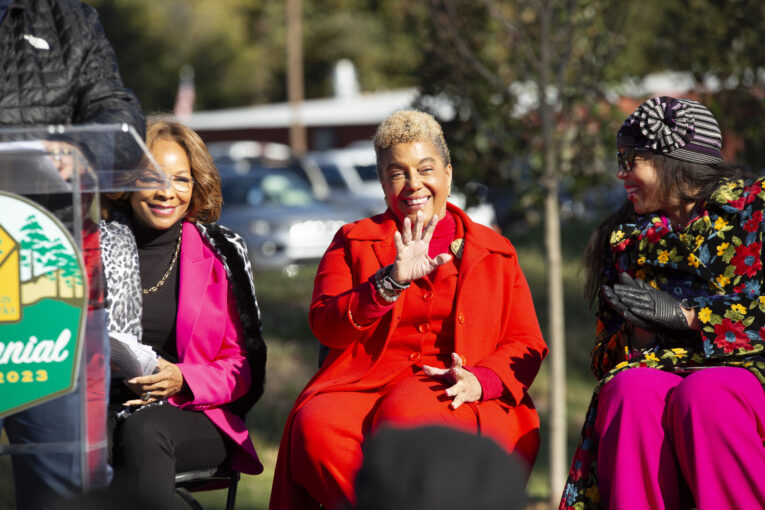Late publisher John H. Johnson’s statue unveiled in Arkansas

BY DEDE YI-FEE
With Angela Courtney
A bronze statue of the late iconic African American publisher John H. Johnson was unveiled last week in the Delta Heritage Trail State Park in Arkansas City, Arkansas, with local authorities, the late publisher’s daughter Linda Johnson Rice, and a large crowd in attendance. There were in fact two historic events in one. The unveiling of the larger-than-life statue marked the opening of John H. Johnson’s Commemorative Plaza in the southern part of the park.
Home away from home
John Harold Johnson’s media empire was based in Chicago, Illinois but his roots go back to Arkansas City, Arkansas where he was born in 1918. After his father, Leroy, died in a mill accident, his mother married another mill worker. Mother and son, after visiting the World’s Fair in Chicago, decided to make it their new home and moved there in 1933. In 1942, at the age of 24, Johnson created Negro Digest which, the following year, became Ebony, the flagship of Johnson Publishing Company, the largest African American publishing company in world history. Other titles followed, including Jet, a pocket-size weekly.
The choice of November 1 for the dedication ceremony of the plaza was no coincidence. That day had been enacted by legislation in 2019 during the 92nd Arkansas General Assembly as John H. Johnson Day, which is celebrated every year.
Succeeding against the odds
Arkansas State Parks and the Walton Family Foundation commissioned Susan Holley Williams, a high-profile artist whose clients have included former President Bill Clinton, to create the sculpture. Prior to the dedication ceremony, Williams, A native of Dumas, Arkansas who now lives in Little Rock, Arkansas and Chicago, Illinois was quoted in an article that appeared in Magnoliareporter.com as saying: “For African American sculptures, most of the ones I am aware of are not because of their business mind. I’ve seen athletes, I’ve seen politicians, religious leaders, but it is rare to find an African American man celebrated because of his business acumen.”
Indeed, Johnson, a boy from the rural south, later attended a major-city high school, DuSable, in Chicago where, as he recounts in his memoir, he was often taunted by the middle-class black kids who made fun of his ragged clothes and country ways. He succeeded against the odds, rising from humble beginnings to become one of the most successful American businessmen. In addition to his publishing empire, he developed a successful line of cosmetics, bought three radio stations, started a book company and a television production company, and had a stake in other companies, including the second most successful Black magazine in the U.S., Essence. He also served on the board of directors of several major companies. The iconic publisher became, in 1987, the first African American to appear on Forbes 400 richest men.
A powerful legacy
Johnson’s legacy to America and to the world, however, is larger than his business success. In our celebration of him in the 2015 edition of our Black History Month issue, we, at The African, wrote, quoting from his Publisher Statement in the issue marking the 50th issue of Ebony: “In a world of negative Black image, we wanted to provide positive Black images. In a world that said Blacks could do few things, we wanted to say they could do anything.”

Last week’s dedication ceremony underscored, once again, John H. Johnson’s place in the history book. The legendary publisher’s daughter Linda Johnson Rice, who took the baton from her father as publisher long before he passed away in 2005, attended the event with her daughter Alexa Rice. She is quoted in an article that appeared in Arkansas Democrat Gazette as saying during the ceremony: “It’s spectacular,” adding in reference to the designer, “I’m so proud of what Susan Williams created. I trusted her, and she did something that was beyond my expectations. I think my father would love this.”
Also in attendance were officials of the park, including Jordan Thomas, the design services manager for Arkansas State Parks, who stressed the educational value of both the plaza and the statue: “We have an educational amphitheater here that our park can use for interpretive events. School groups can come and do educational things.” The event was, indeed, attended by schoolchildren from Little Rock, Dermott, McGehee and Lakeside (Chicot County) districts.
For her part, Lynne Walton of the Walton Family Foundation is quoted by our colleague I.C. Murrell of Arkansas Democrat Gazette as saying: “I’m just very happy to be here today. It’s a very important event for us all to recognize Mr. Johnson.”

